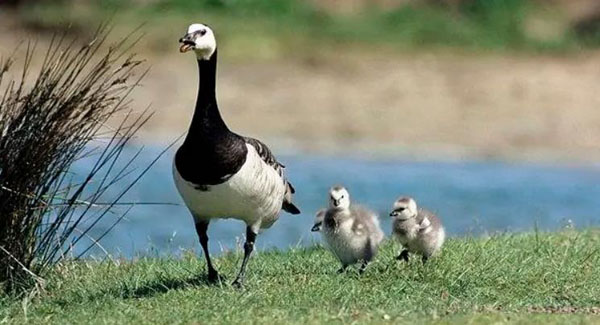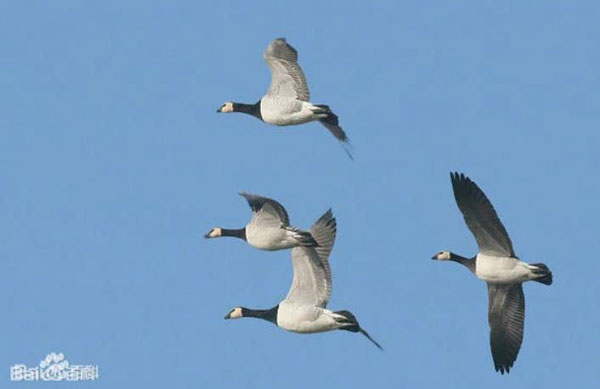Branta leucopsis
IUCN
LCBasic Information
Scientific classification
- name:Branta leucopsis
- Scientific Name:Branta leucopsis,Barnacle Goose
- Outline:Waterfowl
- Family:Aneniformes Anatidae Brancus
Vital signs
- length:58-70cm
- Weight:1400-2400g
- lifetime:19years
Feature
Similar to barnacle geese, but with a white forehead and entire cheek
Distribution and Habitat
Chinese lost birds are found in Henan and Hubei. It breeds in northern Western Europe along the Arctic Circle and the Arctic Ocean, winters in central and southern Western Europe, and is found in Eastern Europe, North Africa and North America.
It inhabits bays, harbours and estuaries, and its breeding habitat is mainly tundra or shrub tundra covered by moss and lichen, especially in higher and drier areas of tundra, or tundra with sparse shrub growth near water. Winter occurs mostly in areas around lakes and reservoirs where alkali-tolerant plants grow, but also in surrounding low-lying saltwater lakes and coastal areas, and occasionally in agricultural fields.
Appearance
The plumage is beautiful gray, white, and black, with a gray back and a white face. It is an easily recognized bracken with a black neck and chest, and a small, pure white head surrounded by gray stripes that contrast with a very pale underbody. The legs and buttocks are mixed black and white, and the mouth is black and forms a distinct triangle in front of the eyes.
Dense feathers; The mouth is more flat, the apex with a mouth nail; The front toes are webbed, the back toes are small and do not step on the ground; The appearance of male and female is different, and the male has a cross-over organ; Tail fat glands developed; There is an enlarged bone sac at the base of the trachea.
Details
It is a typical cold-water Marine bird of medium size, tolerant of cold, and prefers to live in bays, harbors and estuaries. Good at swimming and diving, flying speed is also very fast, flying speed: 60 to 80 kilometers per hour. Sometimes flying in a diagonal, sometimes in a "V" shape, very irregular. When it rises from the water, it is always chirping. At night, they usually live on the water, in shallow water near the water, or on the beach. Every day they fly to the grassland in groups at dawn to feed, return to the water at noon to rest, drink and eat sand, and sometimes roost in the feeding ground at night. When the climate is bad, especially when there is a storm, they often take shelter in the reeds. They form dense groups on the surface of the water.

Mainly to grass or aquatic plants buds, leaves, stems, etc. for food, but also eat roots and plant seeds, and sometimes eat wheat seedlings and other crops in winter, often foraging in groups, groups. The goose's voice is especially high - pitched hogoog hogoog mixed with calls, which sounds like a dog barking.

Breeds in the Arctic tundra, often nesting on inaccessible cliffs. The nest is made of hay, etc., with some feathering in it. Each clutch lays 4-7 eggs, the color of the eggs is olive green and pale yellowish-white, by the female goose alone to incubate the eggs, the male goose during the female goose laying and hatching in the vicinity of the nest as a guard. When female geese leave the nest to forage, they cover it with feathers and grass near the nest. If an intruder comes, the goose will call loudly, sound anxious, and assume a threatening posture, and sometimes even make a posture of preparing to attack the intruder without abandoning the nest. Incubation period is 24-25 days. The young geese have been feathered after hatching and belong to the early mature geese. When the young geese hatch, the male geese also join in the care and defense of the young geese, together with the female geese to lead the young geese to the dense vegetation to forage, 40 to 45 days later, the young geese can fly with the adult geese. It takes 2-3 years for young geese to reach sexual maturity. After giving birth, the mother goose completely moults and is unable to fly for three to four weeks. White-cheeked barngeese flying over Mont Saint-Michel, France. They can fly at 80 kilometers per hour and have been flying non-stop across the Atlantic from Europe to North America.








